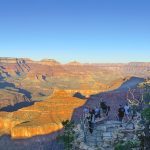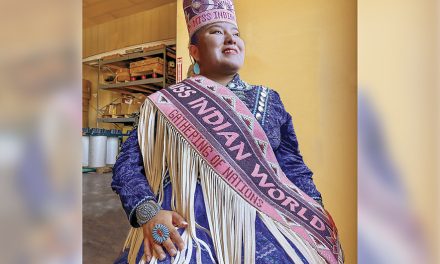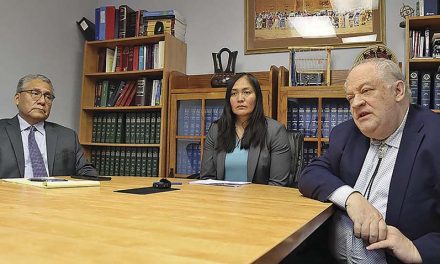
Letters | Carry on the legacy of planting corn
Carry on the legacy of planting corn
Editor,
Ya’ah’teeh shí ké, doo shí Diné across the Navajoland within the Four Sacred Mountain regional areas. I want to share some information about cornfields, particularly on how to raise corn, squash, watermelon, and cantaloupe.
Having a cornfield is a lot of work. After harvesting corn, you have to uproot the dried cornstalks using a shovel. Once the uprooted dried cornstalks are done in the field, you have to put dirt back in the holes where each corn stood. The dried cornstalks have to be hauled off to the sheep and horse corrals as feed or it can be stored and used as feed at a later date when the cold weather is approaching.
As far as I can remember, growing up back in the 1960s in Dennehotso, Arizona, we, as a family, always planted corn, squash, and melons every year. Our late father, Hosteen Todachine, would tell us, “When you have a cornfield, you always take care of it.”
Once you take out the dried leaves, feed it to the livestock or save it as winter feedings. I have a cornfield and I do plant every year even though maintaining it is hard. I always think about my mother and father when I work in the cornfield. It makes me feel good and happy when I work in the field cutting weeds or watering the corn.
My father would say, “Only tough people or certain family will plant crops every year” or he would say, “You’ll know easily which person or family are tough. Those are the type that grows corn every year.”
Having a cornfield is a lot of work. You have to be out there almost every day to take care of the field and carry the shovel around. Once the corn, squash, melons, and cantaloupe are ripe, they’re good to eat as roasted corn, kneel down bread, steamed corn, and fresh mutton stew. You can sell them to get other things, or you can trade fresh crops for firewood, sheep, mutton, or for other valuable things besides hard cash money.
Again, shí ké doo shí Diné, I’m just giving out some information about my experience with cornfields. Those traditions are what our parents and grandparents have passed down to us. We always try to follow in their footsteps in life to keep it strong as we move on. Thank you all and take care.
Dan Todachine
Mariano Lake, N.M.
Taking out statues erases important history
Editor,
Although it doesn’t directly involve the Diné, but is equally concerning and important, the Pueblo Indian people and other indigenous tribal people are protesting the celebration of the brutal conquistador and colonial governor Juan de Oñate in the City of Espanola, New Mexico.
Local New Mexico Rio Arriba County government officials unveiled a statue honoring Juan de Oñate, which the protest erupted into violence and a shooting. Oñate is generally well-known for being extremely oppressive and imposing brutally inhumane treatment on Native Americans under the Spanish inquisition rule in New Mexico (Kingdom of New Spain). In 1598, Oñate ordered the destruction of Acoma Pueblo that resulted in around 1,000 Acoma Indians killed, which is historically known as the “Acoma Massacre of 1599.”
At a trial at Ohkay Owingeh, Oñate sentenced surviving Acoma Indians into slavery (involuntary servitude) and ordered severance (amputation) of one foot of all young Acoma men. Also, Oñate is known for killing plains Indians (“Rayado” Indians) and taking them as slaves. Indian slaves were traded in Mexico.
In 1606, after being summons to Mexico City, Oñate was convicted by the Spanish Crown (King Philip III of Spain) for cruelty to natives, colonists and was banished from New Mexico for life and exiled from Mexico City for five years.
Some people honor Oñate as a famed Spanish explorer and colonialist while Indigenous people condemn Oñate as a murderer and a ruthlessly violent conquistador. Erecting a statue of Oñate is akin to erecting a statue honoring the brutal dictator Adolf Hitler or Joseph Stalin.
A current woke movement intends to forcefully remove all monuments and statues that offend certain groups of people. Removing statues of historical figures erases history that deprives future generations of knowledge of important significant people and past events. Knowing of our past history remains vital and relevant.
Perhaps erecting monuments in honor of tribal leaders and warriors simultaneously alongside statues of conquistadors, generals, and other infamous historical figures may lessen tension among the disputing groups.
Needless to say, fighting about forgotten historical events that occurred hundreds of years ago is nonsensical. Today, many native people intermarried and have deep family roots with Hispanic people as well as other racial groups. Harmony and respect (K’e and Hózhó) is imperative for native people to peacefully reside and co-exist with other nonnative people in the contemporary world and into the distant future.
James Muneta
Tohatchi, N.M.
Navajo Nation should invest in current industrial revolution
Editor,
How many individuals with grazing permits allow one, two, or three families to move in around them without the permission of the surrounding neighbors and how many of them allow other families to move next to them. Let’s face it this is happening right now. How many people are demanding electric hookups that are told they need to have a homesite leases or right of way clearances?
The Navajo Nation Housing solution has to be a coalition from both the grazing permittee holders and the individuals without a grazing permit because we are a growing tribe that cannot be stopped. It requires management of every constituent of the Navajo Nation through votes of tribal leaders such as our Navajo Nation President, Council Delegates, Chapter officials and grazing committee officials.
If we don’t begin the management of the housing issue on the Navajo Nation the land disputes will be the reason our people will start to fight against each other, dividing our Nation even further.
This has been and is currently a rising issue that has been monopolizing the tribal peacemakers’ offices. If we don’t learn from the past, we will be doomed to repeat it.
Housing has many difficulties in it, that requires many follow-ups and local participation from the local chapter constituency. If we would take this opportunity as an economic development strategy working with the local chapters, we could begin utilizing cooperation with the LGA chapters, where a group can work as a CDC (community development corporation), NON-Profit corporation, or a for-profit Corporation, LLC or an L3C company.
They could work in cooperation with a LGA Chapter, and under title 26, section 2 under “definitions” on line 18 describing “eminent domain” the Chapter and the company can begin a housing operation like an apartment complex or a collective mobile home operation all over the reservation.
This could develop housing for the local population including housing for teachers, police officers, firefighters, healthcare professionals, government employees, and other professionals that provide services to our local communities. This will allow sales tax to be captured by the Navajo Nation Tax Commission funding the general budget, to fund the depleting programs that many of our people depend on.
If we allow this housing demand to be handled by a housing authority that is understaffed and overworked, we will have people moving anywhere or nowhere without proper management. This is not a problem this is an opportunity to grow with a purpose and a plan.
After the closure of the Navajo Generating Station and the closure of the Black Mesa Mines the Navajo Nation lost 51% of their annual revenue. The Budget has roughly been $1.3 billion for the past three years but because of this loss of revenue the Navajo Nation has been dipping into the Reserve Trust account, but for how long? How long will we continue to draw from a depleting account? Last year the budget came down to excluding some chapters, or go into a deficit.
Right now, nationally we have a national deficit, a changing political landscape, and national inflation that will not favor the domestic priorities we as a Nation have been capitalizing on. Our priorities as a sovereign nation must take precedence or we will be left without a chair in the ongoing musical chair environment of funding with other tribes. The reality is we are not on any intertribal organizations or have no delegation in the National Congress of American Indian tribes.
If we leave this issue, it will affect our water rights, loss of funding for needed programs for the miscount of the upcoming census. We need to seek solutions for our collective communities, or we will be headed in the same direction as the Alaskan Native communities who forfeit their land for corporations.
As a tribe, we own very little, our primary business is we lease almost everything. I’m going to share with you conceptually what I’m referring to when I talk about a large capacity of potential revenue for the Navajo Nation.
In 1784, the first Industrial Revolution begin with steam and water, plus mechanical productions. The second industrial revolution was with development of electricity and mass production using the assembly line in 1870. The third industrial revolution came in 1969 with the first programmable computer and electronics. It was the beginning of the digital age. We are currently in the fourth industrial revolution with robots learning from humans.
Biometric development is at the forefront of this next revolution. This next revolution is the birth of artificial intelligence, cyber technology, physical systems and applications. This is where I believe the Navajo Nation can begin developing the physical matter of this technical revolution.
In 2021 the national news began reporting on a metal shortage, and so alternative metals were being sought. One of these metals is called poly silicone, which is the substance in many of the car parts we have today and are using. It is also the substance used for solar panels and semiconductor development.
Semiconductor development is a national security priority. Both the military and the private sector are seeking this material in its raw form. It can run anywhere from $10-$15 per kilogram. But in its developed state one cylinder of the stuff that has been developed through a process of polishing and layering is worth $17,000 dollars per wafer which is about 6 to 8 inches and is as thin as card stock paper, or a traditional business card.
There are grants and guaranteed loans available for this program. The grant for this kind of enterprise includes education and community development money to bring people to this industry and develop another generation to keep the process of production moving. The substance is made of materials to create the crystals, the sand that is required, which I believe LeChee has an abundance of. The other substance is coal which is from the Black Mesa mines.
Coal and sand are minerals the Navajo Nation owns according to the 1971 Supreme Court ruling. We currently have an abundance of both of these raw materials right now on the Navajo Nation and we have an opportunity through many grants totaling in the numbers of $35 billion, and there are guaranteed loans up to $75 billion to enter this industry that is available within the United States.
This $400 billion industry potentially can be an industry the Navajo Nation can develop and participate in.
Neal Riggs
Winslow, Ariz.








 Highway 264,
Highway 264, I-40, WB @ Winslow
I-40, WB @ Winslow